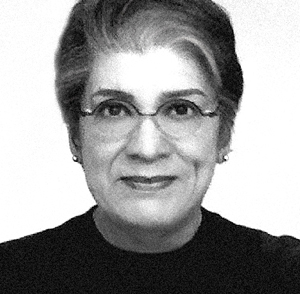
The Royal Chicano Air Force (RCAF) is a Sacramento, California-based art collective, founded in 1970 by Ricardo Favela, José Montoya and Esteban Villa. It was one of the "most important collective artist groups" in the Chicano art movement in California during the 1970s and the 1980s and continues to be influential into the 21st century.

Norma Elia Cantú is a Chicana postmodernist writer and the Murchison Professor in the Humanities at Trinity University in San Antonio, Texas.

Chicana feminism is a sociopolitical movement, theory, and praxis that scrutinizes the historical, cultural, spiritual, educational, and economic intersections impacting Chicanas and the Chicana/o community in the United States. Chicana feminism empowers women to challenge institutionalized social norms and regards anyone a feminist who fights for the end of women's oppression in the community.

Yolanda Margarita López was an American painter, printmaker, educator, and film producer. She was known for her Chicana feminist works focusing on the experiences of Mexican-American women, often challenging the ethnic stereotypes associated with them. Lopez was recognized for her series of paintings which re-imagined the image of the Virgen de Guadalupe. Her work is held in several public collections including the Smithsonian American Art Museum, the San Francisco Museum of Modern Art, and the Los Angeles County Museum of Art.
Ester Hernández is a California Bay Area Chicana visual artist recognized for her prints and pastels focusing on farm worker rights, cultural, political, and Chicana feminist issues.

Galería de la Raza (GDLR) is a non-profit art gallery and artist collective founded in 1970, that serves the largely Chicano and Latino population of San Francisco's Mission District. GDLR mounts exhibitions, hosts poetry readings, workshops, and celebrations, sells works of art, and sponsors youth and artist-in-residence programs. Exhibitions at the Galería tend to feature the work of minority and developing country artists and concern issues of ethnic history, identity, and social justice.
Nora Chapa Mendoza is a Texas-born artist. She has been named Michigan Artist of the Year and in 1999 she received the Governor's Arts Award. In 1996, she was one of eight artists that participated in the renovation of Detroit's Music Hall.

Linda Vallejo is an American artist known for painting, sculpture and ceramics. Her work often addresses her Mexican-American ethnic identity within the context of American art and popular culture. The founder of the commercial art gallery Galería Las Américas, she is also an arts educator and has been involved intraditional Native American and Mexican rituals and ceremonies for many years.

Favianna Rodriguez is an American artist and activist. She has self-identified as queer and Latina with Afro-Peruvian roots. Rodriguez began as a political poster designer in the 1990s in the struggle for racial justice in Oakland, California. R is known for using her art as a tool for activism. Her designs and projects range on a variety of different issues including globalization, immigration, feminism, patriarchy, interdependence, and genetically modified foods. Rodriguez is a co-founder of Presente.org and is the Executive Director of Culture Strike, "a national arts organization that engages artists, writers and performers in migrant rights. "

Jovita Idar Vivero was an American journalist, teacher, political activist, and civil rights worker who championed the cause of Mexican Americans and Mexican immigrants. Against the backdrop of the Mexican Revolution, which lasted a decade from 1910 through 1920, she worked for a series of newspapers, using her writing to work towards making a meaningful and effective change. She began her career in journalism at La Crónica, her father's newspaper in Laredo, Texas, her hometown.

Judithe Hernández is an American artist and educator, she is known as a muralist, pastel artist, and painter. She is a pioneer of the Chicano art movement and a former member of the art collective Los Four. She is based in Los Angeles, California and previously lived in Chicago.
Juana Alicia is an American muralist, printmaker, educator, activist and, painter. She has been an educator for forty years. Juana Alicia, as part of the faculty Berkeley City College, founded and directed the True Colors Public Art program. Her sculptures and murals are principally located in the San Francisco Bay Area, Nicaragua, Mexico, Pennsylvania, and in many parts of California.

René Yañez was a Mexican-American painter, assemblage artist, performance artist, curator and community activist located in San Francisco, California. He was a well-known contributor to the arts of San Francisco and is a co-founder of Galería de la Raza, a non-profit community focused gallery that features Latino and Chicano artists and their allies. In the early 1970s, he was one of the first curators in the United States to introduce Mexico's Día de Muertos as a contemporary focus and an important cultural celebration.
María Teresa García Pedroche is an American award winning artist and curator.
Teresa Serrano (1936) is a Mexican painter, sculptor, and filmmaker. She gained recognition through her work in filmmaking in the mid to late 1990s. Her main focus has been "to make forceful commentaries on power relationships, sexism, and violence against women".
Lorraine Garcia-Nakata is an American artist who works with various mediums including pastel, charcoal, ceramics, printmaking, installation, sculpture, and paint. Her work surrounds themes of the daily life, portraiture, and realism and is known for her large scale artworks. She is a member of the Royal Chicano Air Force (RCAF) artist collective since 1974.
Celia Herrera Rodriguez is an educator, painter, and performance and installation artist.

Geri Montano, otherwise known as Geralyn Marie Montano, is a contemporary Native American artist who incorporates themes of Native American heritage, feminism, and societal issues into her work.
Juanita Jaramillo Lavadie is a contemporary weaver, textile scholar and muralist based in New Mexico. Her art is centered on the acequia system in Taos County, Northern, New Mexico and is influenced by traditional Hispano and Indigenous cultures. Her work primarily focuses on water rights in Taos County.
Graciela Carrillo is a Chicana artist and muralist in San Francisco and member of the all-female Chicana/Latina artist group Mujeres Muralistas. She is a co-founder of Galería de la Raza, a gallery utilized to showcase the everyday lives of the Chicano community through art during the Chicano Civil Rights movement through the Chicano muralist movement.















